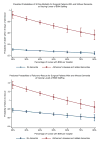Lower Postsurgical Mortality for Individuals with Dementia with Better-Educated Hospital Workforce
- PMID: 29558568
- PMCID: PMC6105464
- DOI: 10.1111/jgs.15355
Lower Postsurgical Mortality for Individuals with Dementia with Better-Educated Hospital Workforce
Abstract
Objectives: To investigate whether care in a hospital with more nurses holding at least a Bachelor of Science in Nursing (BSN) degree is associated with lower mortality for individuals with Alzheimer's disease and related dementias (ADRD) undergoing surgery ADRD.
Design: Cross-sectional data from 2006-07 Medicare claims were linked with the Multi-State Nursing Care and Patient Safety Survey of nurses in 4 states.
Setting: Adult, nonfederal, acute care hospitals in California, Florida, New Jersey, and Pennsylvania (N=531).
Participants: Medicare beneficiaries aged 65 and older with and without ADRD undergoing general, orthopedic, or vascular surgery (N=353,333; ADRD, n=46,163; no ADRD, n=307,170).
Measurements: Thirty-day mortality and failure to rescue (death after a complication).
Results: Controlling for hospital, procedure, and individual characteristics, each 10% increase in the proportion of BSN nurses was associated with 4% lower odds of death (odds ratio (OR)=0.96, 95% confidence interval (CI)=0.93-0.98) for individuals without ADRD, but 10% lower odds of death (OR=0.90, 95% CI=0.87-0.94) for those with ADRD. Each 10% increase in the proportion of nurses holding a BSN degree or higher was associated with 5% lower odds of failure to rescue (OR=0.95, 95% CI=0.92-0.98) for individuals without ADRD but 10% lower odds of failure to rescue (OR=0.90, 95% CI=0.87-0.94) for those with ADRD.
Conclusion: Individuals undergoing surgery who have coexisting ADRD are more likely to die within 30 days of admission and die after a complication than those without ADRD. Having more BSN nurses in the hospital improves the odds of good outcomes for all individuals and has a much greater effect in individuals with ADRD.
Keywords: dementia; mortality; nurse education; workforce.
© 2018, Copyright the Authors Journal compilation © 2018, The American Geriatrics Society.
Conflict of interest statement
Figures

Similar articles
-
Hospital nursing and 30-day readmissions among Medicare patients with heart failure, acute myocardial infarction, and pneumonia.Med Care. 2013 Jan;51(1):52-9. doi: 10.1097/MLR.0b013e3182763284. Med Care. 2013. PMID: 23151591 Free PMC article.
-
Nurse staffing and postsurgical outcomes in black adults.J Am Geriatr Soc. 2012 Jun;60(6):1078-84. doi: 10.1111/j.1532-5415.2012.03990.x. J Am Geriatr Soc. 2012. PMID: 22690984 Free PMC article.
-
Assessment of Rural-Urban Differences in Health Care Use and Survival Among Medicare Beneficiaries With Alzheimer Disease and Related Dementia.JAMA Netw Open. 2020 Oct 1;3(10):e2022111. doi: 10.1001/jamanetworkopen.2020.22111. JAMA Netw Open. 2020. PMID: 33090226 Free PMC article.
-
Optimizing coding and reimbursement to improve management of Alzheimer's disease and related dementias.J Am Geriatr Soc. 2002 Nov;50(11):1871-8. doi: 10.1046/j.1532-5415.2002.50519.x. J Am Geriatr Soc. 2002. PMID: 12410910 Review.
-
Improving quality measurement for dementia care.Alzheimers Dement. 2025 Apr;21(4):e70154. doi: 10.1002/alz.70154. Alzheimers Dement. 2025. PMID: 40235084 Free PMC article. Review.
Cited by
-
The association of mental health disease with perioperative outcomes following femoral neck fractures.J Clin Orthop Trauma. 2019 Oct;10(Suppl 1):S77-S83. doi: 10.1016/j.jcot.2019.01.002. Epub 2019 Jan 3. J Clin Orthop Trauma. 2019. PMID: 31695264 Free PMC article.
-
Variations in nursing baccalaureate education and 30-day inpatient surgical mortality.Nurs Outlook. 2022 Mar-Apr;70(2):300-308. doi: 10.1016/j.outlook.2021.09.009. Epub 2021 Nov 8. Nurs Outlook. 2022. PMID: 34763898 Free PMC article.
-
Accountable care organizations and use of surgery among patients with Alzheimer disease and related dementias.Am J Manag Care. 2023 Jul;29(7):349-355. doi: 10.37765/ajmc.2023.89395. Am J Manag Care. 2023. PMID: 37523752 Free PMC article.
-
Changes in proportion of bachelor's nurses associated with improvements in patient outcomes.Res Nurs Health. 2021 Oct;44(5):787-795. doi: 10.1002/nur.22163. Epub 2021 Jun 14. Res Nurs Health. 2021. PMID: 34128242 Free PMC article.
-
Mortality Among the Dementia Population in Not-For-Profit Hospitals with Better Nursing Resources.J Aging Soc Policy. 2024 Jan 31:1-15. doi: 10.1080/08959420.2023.2297596. Online ahead of print. J Aging Soc Policy. 2024. PMID: 38293888 Free PMC article.
References
-
- Dewing J, Dijk S. What is the current state of care for older people with dementia in general hospitals? A literature review. Dementia. 2016;15:106–124. - PubMed
Publication types
MeSH terms
Grants and funding
LinkOut - more resources
Full Text Sources
Other Literature Sources
Medical

